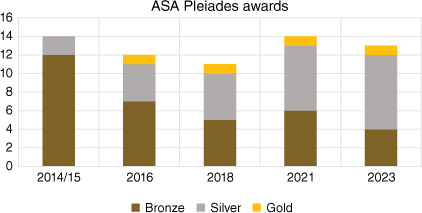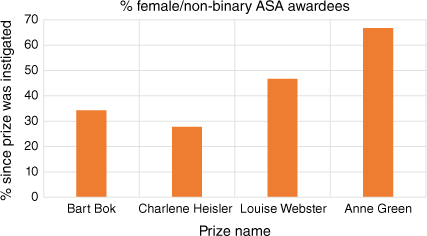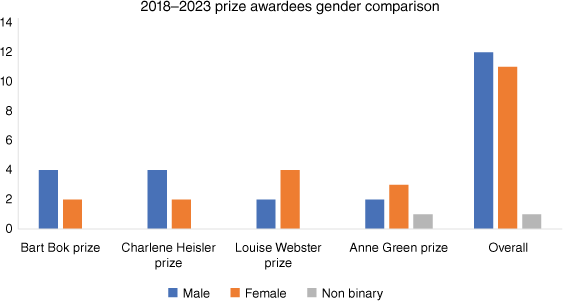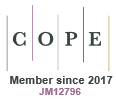Gender diversity in Australian astronomy: the Astronomical Society of Australia 1966–2023
Toner Stevenson A * and Nick Lomb
A * and Nick Lomb  B
B
A
B
Abstract
In this paper we examine the changes in the diversity of astronomers working in Australia, particularly the ratio of women compared to men, from 1966, when the Astronomical Society of Australia (ASA) was formed, to 2023. This was a pivotal time, as there was a significant change to workplace law that enabled women who worked for Commonwealth departments to retain their permanent position once they married. We consider the impact on gender diversity and other marginalised groups in astronomy due to this and other changes in the law, through the membership records of the ASA. We focus on the experiences of female astronomers who have been at the leading edge of change, and women and men who have instigated strategies to increase the percentage of women employed in astronomy. The successes of two Australian Research Council (ARC) centres of excellence in achieving gender balance are considered as providing best practice models.
Keywords: History of Australian astronomy, The Astronomical Society of Australia, Women in astronomy, Gender equity in science, Pleiades awards, Post-war Australian astronomers, Beverley Wills (née Harris), Betty Louise Turtle (née Webster), Priscilla Bok (née Fairfield).
Introduction
The gender balance in astronomy has changed since the formation of the peak body for astronomy in Australia, the Astronomical Society of Australia (ASA), in 1966. The period following the formation of the ASA was also one of significant change in Australian workplace law. The changes within the demographics of astronomy since that time are significant, but still the male/female ratio is unequal up to the present time. We use ASA membership records to get indications of when change occurred as we have previously found that the ASA provides a good representation of Australian astronomy.1 Noting and reporting on when and how change was instigated is also, as we shall see, intrinsic to the society’s membership and strategies. There is a complementary paper to this one that tracks the changes that have occurred in astronomy in Australia since the mid-twentieth century and the impact of these changes on ASA membership.
In this paper we take for granted that gender parity in astronomy is desirable to improve retention in the workforce and to ensure equal representation on decision-making committees. These reasons and more were outlined by Australian astrophysicist Lisa Kewley and others in 2023 in a paper that advocated direct and targeted recruitment, equity training and retention strategies to achieve a gender balance in astronomy.2
Historian Jane Carey’s research into the history of women in science in Australia has revealed that, although some women have been present in many fields of science, women were excluded due to the elite nature and high cost of secondary and tertiary education and the social conditioning that women should prioritise domestic duties.3 Throughout most of the nineteenth century Australian women were relegated to roles that they were seen as competent in and confined to these, as also captured by science historian and theorist, Claire Hooker: ‘As in England and America, Australian women stuck to what were seen as women’s roles in science, they were popularisers rather than theorists, illustrators rather than authorities’.4 Women working in science during this era were predominantly the daughters, sisters and/or wives of male scientists and, also according to historian Farley Kelly, their success depended on how they could remove themselves from domestic duty.5 Hooker examined a few successful husband and wife teams, in which the woman had agency and recognition, if not a separate income.6
There are many examples of husband-and-wife teamwork in the history of Australian astronomy. During the 1911 total solar eclipse expedition to Bruny Island, Tasmania, Annie Louisa Virginia Dodwell (née Trehy, 1870–1924), who was married to South Australian government astronomer George Dodwell (1879–1963), measured changes in temperature during the eclipse, and she was responsible for much of the logistical aspects of that and later eclipse expeditions undertaken by Dodwell.7 Gerard (1918–95) and Antoinette (1921–87) de Vaucouleurs obtained the luminosity and spectral classification of 366 stars at Mt Stromlo observatory from 1951 to 1957. Bart (1906–83) and Priscilla Bok (née Fairfield, 1896–1975), pictured in Fig. 1, followed the de Vaucouleurs at Mt Stromlo observatory from 1957 to 1966 and are both recognised not only for their astronomy research, but also for fostering education, in particular mentoring PhD students, especially women.8 Nonetheless, according to Kelly, Hooker and Carey, remaining unmarried is an attribute recognised as a significant factor in the lives and choices of women who became accomplished scientists,9 and there were legal, as well as social, reasons for this.
Bart and Priscilla Bok at Mt Stromlo 1964. Image courtesy of the National Archives of Australia, colourised. NAA: A1200, L50804.
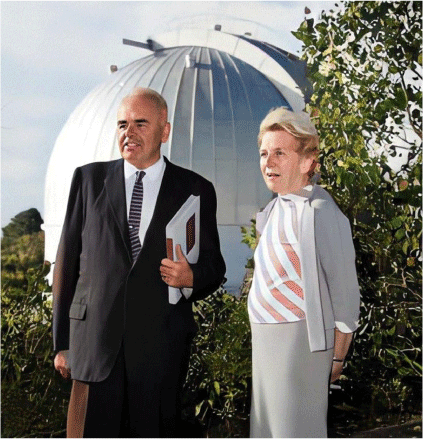
Carey’s research also showed that few men or women had Bachelor of Science degrees until after the first world war.10 In Australia there were no research specific professional or academic jobs in astronomy for women until after the second world war, even though some women who were employed in non-professional jobs managed to incorporate research into their work.11 It is not surprising then that as Carey, Kelly and Hooker described, many Australian women science graduates became school teachers rather than research scientists, which leads us to how astronomy work became gender-specific.12
The roles of the women who worked as star measurers and computers in Australia on the Astrographic Catalogue from the 1890s were modelled on the female measuring bureaux established at Paris Observatory and then adopted in Britain and elsewhere to become normative in astronomy for decades.13 This gender-specific division of labour meant that although women had paid employment in astronomy, it was at a much lower rate than men, and that they undertook repetitive roles with little opportunity for investigating and publishing research. In many cases women were also not acknowledged for new findings, for example, when the women working at Perth Observatory observed new double stars on the glass plates that they measured, noted and checked, their names were not acknowledged in the published papers.14
This model persisted for decades in astronomy, underpinned by the disadvantages of limited access to university education, discriminatory workplace legislation and unequal pay. Although some women proved they had research skills in astronomy, such as Mary Emma Greayer (1861–1910) who observed and catalogued reference stars at Adelaide Observatory in the 1890s, and Charlotte Emily Fforde Peel (1876–1974) who managed a team of star measurers and computers at Melbourne Observatory and measured the astrometric positions of a comet, in the early twentieth century. In each case their careers in astronomy ceased when they married.15 The ‘first wave’ of feminism that had achieved franchise for white Australian women at the time of Federation, had not achieved fair working conditions nor economic opportunities.16
The year 1939 marked a pivotal time in scientific research in Australia when CSIR expanded its divisions beyond supporting primary industries and by 1947 Radiophysics was amongst the largest of the six new divisions.17 Under the direction of Joseph Pawsey (1908–62), the team transformed radar stations at North Head, Collaroy and Dover Heights to suit the detection of solar radio waves. In collaboration with Ruby Payne-Scott (1912–81) and Lindsay McCready (1919–76), Pawsey published their findings, that were fundamental to the development of radio astronomy, in Nature.18
In 1941, during the war, Ruby Payne-Scott was employed by the Council for Scientific and Industrial Research (CSIR) in the Radiophysics Laboratory at the University of Sydney to monitor planes off the coast of Sydney. From 1944 to 1951, she worked in radio astronomy, making significant discoveries in solar radio astronomy and the construction and application of the Potts Hill interferometer.19 During 1948, her marriage, which had taken place in 1944, became known and she unsuccessfully fought to retain her permanent position. Payne-Scott was demoted to a casual employee and lost many financial benefits, due to a legal bar preventing women employed in the Commonwealth public service from retaining permanent employment once they married. Payne-Scott’s work was essential to the development and publication of early radioastronomy.
A ‘second wave’ feminist movement grew post World War 2 and emerged in the 1960s with changes to a diverse range of liberation and inequality measures across race and class as well as gender in their sights.20 Changes in federal legislation to achieve some of these working rights are plotted on a timeline as shown in Fig. 2.
Timeline showing relevant federal diversity actions from the year of foundation of the Astronomical Society of Australia in 1966, until 2023. These are mapped against the two IAU general assemblies held in Australia and strategies implemented by the ASA which indicate cultural change and accountability in astronomy organisations as well as the ASA.
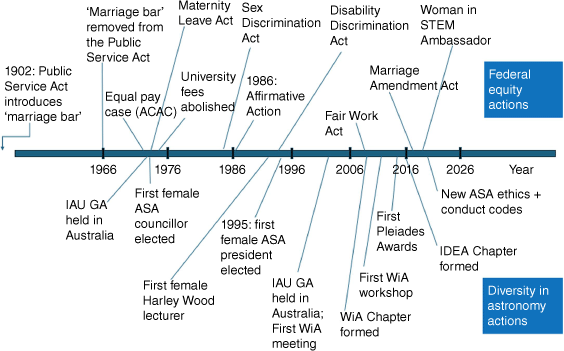
The ‘marriage bar’ was removed from the Commonwealth Public Service Act in 1966, in the same year that the ASA was formed.21 This legally binding gender discrimination, introduced in 1902, prevented married women having access to permanent employment in the Commonwealth public service, and most states and universities had similar acts.22 It had created what historian Desley Deacon referred to as ‘a dual labour market’ and even though the ‘marriage bar’ was removed, the implications of the historical separation between men and women continued to permeate the workforce.23 Equal pay and the same working conditions as men, such as not be forced to retire at age sixty, and to be supported to return to the workforce, without penalty, after childbirth, were just some of the next changes sought.
In 1972 the Equal Pay for Work of Equal Value Principles ruling was accepted by the Australian Conciliation and Arbitration Commission.24 Muriel Heagney (1885–1974) was one of the earliest champions of equal pay for women doing equal work to men in Australia.25 Her campaign began in 1919, after she left her job measuring stars for the Astrographic Catalogue at Melbourne Observatory.26 She lived to see the ruling passed, but implementation of this act has been ongoing. Maternity leave was legislated for Australian public servants in 1973.27 Prior to these changes it was very difficult for women to have a career and a family, and Ruby Payne-Scott’s life is just one of many testimonies to that struggle.
The timeline in Fig. 2 plots many of these legislated workplace changes against gender equity actions taken by, or which occurred in, the ASA. Many of these had implications for all astronomers in raising awareness of gender equity and accountability. To focus on the history of gender diversity in astronomy we will now examine gender demographics of ASA members and the changes to its governance, programs and values to increase diversity in the astronomy workforce.
The ASA has published lists of members that have been analysed for gender data.28 After 2007, the data have become more accessible, as the society’s Women in Astronomy (WiA) chapter began collating gender statistics in astronomy. Since 2009 the ASA Council has also gathered membership gender data in each of the membership categories of ‘male’, ‘female’ and an option for ‘prefer not to say’ and, more recently, to identify as ‘intersex’ has been available.
1966–89: the beginnings of gender equity in professional astronomy
The Astronomical Society of Australia (ASA) is an organisation of professional astronomers in astronomy and related fields in Australia. Its members are statistically representative and indicative of the demographics and location of astronomers and astronomy students in Australia as shown in the paper complementary to this.29 When the society was formed in 1966, in the list of 145 names invited to join, eight were women: Margaret Clarke, Beverley Harris, five postgraduate students, including Donna Dee Hain, Lindsey Fairfield Smith and Louise Webster (1941–90), additionally Berenice Page (?–1970), who was an accomplished amateur astronomer, was invited to join.30 At its first Annual Scientific Meeting (ASM) held in December that year, there were 125 attendees of which four were women. By 1969, there were eleven women members of the ASA as shown in Fig. 3. By comparison, in that year, women were 16% of full-time university professors, 18% of academic full-time teaching and/or research academic staff, and 29% of students enrolled at Australian universities.31 Over the following decade much changed in the legal status of women in Australia, but this did not initially impact the ASA, as by 1979 both the number of ASA members, and the percentage of women ASA members, as shown in Fig. 4, had decreased.
Total ASA members by gender from 1969 to 2023 not including corporate or alumni members. Data as provided for June/July in each year analysed.
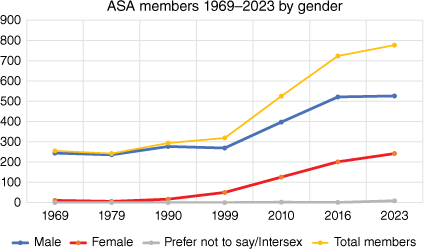
The percentage of female members in the ASA 1969–2023. The rise of the percentage of women who were accepted as students from 1990, fellows from 1999 and honorary fellows from 2010 is particularly significant. This graph does not include associate, alumni and corporate membership categories. Data as provided for June/July in each year analysed.
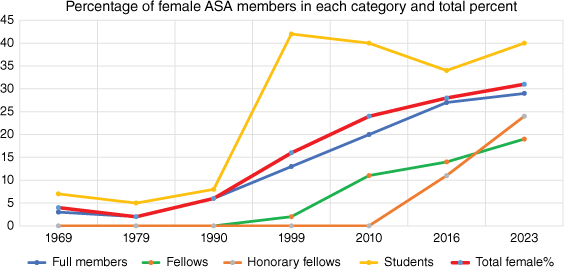
Some of the women who were ASA members during this period have been called ‘trail-blazing women’ due to their big-impact astronomy publications.32 Lindsey Fairfield Smith and Betty ‘Louise’ Webster were both PhD students at Mt Stromlo at the same time as Priscilla Bok was there. Priscilla, as previously mentioned, was the wife of Mt Stromlo Director Bart Bok, and an astronomer in her own right. Smith is recognised for her publications mapping Wolf-Rayet Stars and Webster for her mapping of southern planetary nebulae, discovery of X-Ray sources and the early identification of a black hole.33 Smith, Webster and Priscilla Bok had international careers and were influential in mentoring other women in Australia and overseas. There were women whose research with more established astronomers was acknowledged and published, such as Janice Milton, who with Richard McGee (1921–2012), researched the distribution of neutral hydrogen in the Large Magellanic Cloud. Their survey was published in 1966 and was among the top ten cited papers in astronomy in Australia for the period 1966–9.34
There were two women who joined the ASA as students during this period and who became influential in astronomy research and leadership, and for their advocacy for women astronomers and gender equity: Anne Green (née Barwick) and Elaine Sadler.
During this period a committee chaired by the first ASA President, Harley Weston Wood (1911–84), was responsible for the first International Astronomical Union (IAU) general assembly in Australia that occurred in Sydney in 1973.35 As noted in the conference newspaper, the participation of women professional astronomers was very small, but the attendance of Margaret Burbridge (1919–2020), then Director of Royal Observatory Greenwich, was considered a highlight of the event. There was a women’s organising committee, but its role was limited to arranging events for the wives of participating astronomers and exhibitions of art and wildflowers.36
The presidency of the ASA is a two-year term. Typically, the president is elected after a term as vice-president. After Harley Wood, there were solely male presidents, vice-presidents and councillors until 1973, when Beverley Wills (née Harris) was elected as a councillor. Wills obtained her doctorate in astronomy from the ANU for her research on radio spectra of galaxies and QSOs (quasars) that was at the forefront of radio astronomy research. She served on the council for two years then moved to the USA as a visiting researcher at Ohio State University, followed by a position in the astronomy department of the University of Texas.37 There was a substantial gap before the next woman, Betty ‘Louise’ Webster was elected to the council in 1989. She was then head of the Department of Astrophysics and Optics at the University of New South Wales (UNSW), and had a distinguished career as an astronomer and educator.
A significant social change during this period was the removal of university fees in 1974. Carey has published indicative percentages of women enrolled in science degrees at Australian Universities from 1945 to 2020, and it is possible to discern a trend of an increased percentage of women enrolled in science, which rose from 31.3% in 1974 to 37.8% in 1989.38
The 1984 Sex Discrimination Act made it illegal to discriminate or harass anyone on the basis of gender, sexual orientation, marital status, pregnancy and other direct and indirect areas of difference.39 Then in 1986, there was a further step taken to eliminate discrimination within the workplace and areas of education when the Commonwealth Affirmative Action (Equal Opportunity for Women) Act was legislated. This required Commonwealth government departments, universities and all related contractors to submit a plan of action demonstrating how they would achieve a non-discriminatory and equitable organisation.
1990–2009: affirmative action and evidence of increased gender diversity
The Affirmative Action Act required reports and it raised the impetus for equity in leadership and this had a ripple effect through astronomy. In 1994, Jenny Nicholls was appointed the first female editor of the Publications of the Astronomical Society of Australia (PASA). Of the nine editors since, three have been female, including Nicholls.40 This period saw notable changes in the gender balance across astronomy as 11% of the workforce were female in 1995, but by 2005 this had risen to 20%.41 The demographics and the number of ASA members parallels this change, as shown in Fig. 3 and the total number of members increased with the main contributor to this increase the number of student members as shown in Fig. 5. This was partially due to the success of Swinburne, which gained university status in 1992, as well as the growth in student enrolments in other universities.42 By 2009, the overall percentage of female ASA members increased from 6 to 24% as shown in Fig. 4.
ASA members from 1969 to 2023 by category not including corporate or alumni members. There was a significant increase in students from 1999 to 2010. Data as provided for June/July of each year analysed.
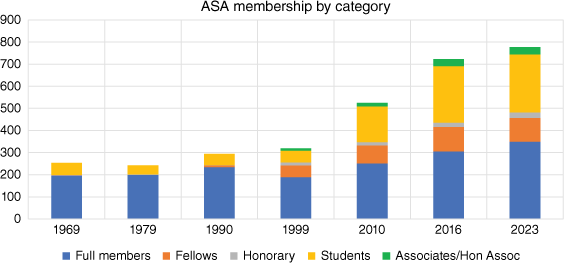
In 1991, Elaine Sadler was elected to the ASA council and in 1993 she was elected as the first female vice-president, followed by a two-year presidency in 1995–6. Since then, the presidency has been held by fourteen astronomers, of whom five, including Sadler, have been female.43 The ASA introduced a student representative as a council observer in 1994 and these representatives typically undertake a one-year term. The requirement for election of the student representative by student members was added to the ASA constitution in 2020 and 54% of the student observers have been female from 1994 to 2023.
In 2001, there was an increase in women in academia, and in some cases, such as the employment of Rachel Webster at the University of Melbourne, this led to an increase in students, with a percentage increase in the number of women undertaking PhD degrees.44 This is demonstrated in the positive trajectory of student members of the ASA since 1999 as shown in Fig. 5 and an uplift in the percentage of female student members as shown in Fig. 6.
The number and diversity of ASA student members 1969–2023. Because of the low numbers, those who selected ‘Prefer not to say’ or ‘Intersex’ have been combined. Data as provided for June/July in each year analysed.
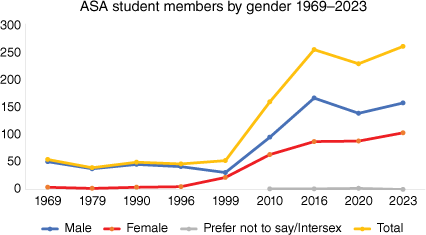
An IAU General Assembly was held in Sydney in 2003. The organising committee included an Executive Committee Working Group dedicated to women in astronomy, of which Australian astronomers Anne Green, who was president of the ASA, and Sarah Maddison were members.45 Green and Maddison organised a workshop for 180 delegates and after the keynote address, the goals for the group were presented and a pamphlet distributed with data about women in astronomy. Since 2003, the IAU General Assembly has always included a Women in Astronomy workshop and Green and Maddison became co-chairs of the group. The IAU Women in Astronomy working group has continued to produce programs and reports, but its effectiveness depends on leveraging resources from other IAU committees and being part of programs, such as the International Year of Astronomy.
The International Year of Astronomy (IYA) was an IAU initiative held in 2009 to celebrate 400 years since Galileo Galilei recorded the first observations through a telescope and Johannes Kepler published Astronomia Nova. In Australia, an extensive national program of inclusive initiatives supported by the ASA was developed to increase awareness of astronomy and it promoted women as authorities in the field. As part of the She is an Astronomer program, a book on Ruby Payne-Scott46 was launched and sixty-two profiles of women astronomers were published, including sixteen profiles of Australian women astronomers.47
The ASA funded several other IYA programs including the ‘Stellar Scholarships’ for female high school students.48 There was an extensive Indigenous Australian astronomy program with a symposium in Canberra, the launch of the Emu Dreaming book, public talks titled First Astronomers, and an exhibition titled Under One Sky of astronomy-related Indigenous artworks.49 Another major IYA exhibition was titled From Earth to the Universe and presented in the Powerhouse Museum, Sydney. Co-curated by the second author of this paper, Nick Lomb, and astrophotographer David Malin, the exhibition featured Malin and Sydney Observatory guide-lecturer Silvia Choi. CSIRO astronomer Ilana Feain launched the exhibition.50 The IYA raised the profile of astronomy and acknowledged gender diversity. There have been others who have profiled female astronomers including Bhathal who interviewed three female astronomers for their personal stories: Rachel Webster, Naomi McClure-Griffiths and Penny Sackett, as part of a set of thirty-eight interviews of astronomers.51
The year 2009 was also important in workplace equity when the Fair Work Act consolidated national employment standards which included equal pay, parental leave, superannuation and more. This legislation and the increased attention given to women astronomers during the IYA was impetus for change, as will be seen in the next section.
2010–23: Women in Astronomy, IDEA chapter and the Pleiades awards
In 2009, Green and Maddison founded the Women in Astronomy chapter (WiA) of the ASA with Maddison becoming its first chair in 2010. The chapter’s goals were outlined by outgoing president Lister Staveley-Smith: ‘to raise the profile of women in Australian astronomy, collect statistics on the status of women in astronomy, provide information, liaise with other international bodies representing the status of women in astronomy, and organise women in astronomy meetings.’52 Incoming ASA President Kate Brooks encouraged all astronomers, male and female, to join the WiA chapter and its committee included both sexes. In its first year of enrolment, WiA attracted seventy-eight members, representing 14% of the ASA membership. Led by WiA Chair, Lisa Harvey Smith, the first well-attended WiA workshop was held in Sydney in 2011, as shown in Fig. 7.53 Naomi McClure Griffiths spoke about her experiences as a parent, and that, even though she had travel support due to the Ruby Payne-Scott award, much more needed to be done to support women missing out on promotion and grant applications due to maternity leave.54 The importance of mentors was identified and the idea for ‘Speed-meet a mentor’ was canvassed. At the 2011 ASM, seventy people participated in this activity, which was held again in 201255 and at almost all ASMs since then.
Participants at the 2011 WiA workshop held in Sydney. Kate Brooks, who was the ASA president in 2011, is in the second row second from the right, seated next to Sarah Maddison, Chair of the WiA. The first author of this paper, Toner Stevenson, is also in the second row, fifth from the right. Reproduced with permission from the IDEA ASA website.
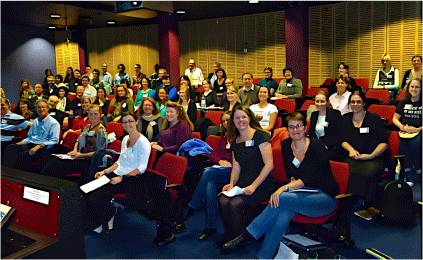
The involvement of male astronomers, who constituted 36% of the WiA membership in 2011, proved that a more diverse workforce was deemed necessary and supported in many organisations. Nobel prize winner and later Vice-Chancellor of the Australian National University (ANU), Brian Schmidt, opened the 2014 WiA workshop held at the ANU in Canberra. At that workshop, new awards, called the Pleiades awards, were mooted. These are discussed below and they relate to actions that organisations and individuals can take to improve diversity. Of particular note were the personal stories shared by Minh Huynh and Lisa Harvey-Smith and the workshop that followed a presentation about privilege and unconscious bias.56
At the 2015 WiA workshop, Elaine Sadler, director of the ARC Centre of Excellence for All-Sky Astrophysics (CAASTRO), presented the methodology and key performance indicators that the CAASTRO Gender Action Committee had developed to improve gender equity.57 This committee, chaired by the aforementioned Brian Schmidt, who was the CAASTRO Chief Investigator, was critical to understanding the main issues faced by CAASTRO researchers. It informed the workplace changes made by Sadler and inaugural CAASTRO Director, Bryan Gaensler. In 2017, the Centre for All Sky Astrophysics in 3 Dimensions (ASTRO 3D) leadership team, under inaugural Director Lisa Kewley, designed a similar but even more extensive approach, which has resulted in a 50% gender balance across the organisation at all levels over a five-year period.58 The methodologies and findings of these two ARC Centres of Excellence hold insights and relevance for all organisations in the sector.
In 2016, the ASA Women in Astronomy chapter was renamed the Inclusion, Diversity and Equity in Astronomy (IDEA) chapter to be inclusive of other forms of diversity and broaden its diversity mandate. The IDEA chapter terms of reference include equal representation of women and men on its committee. On the ASA website, the IDEA chapter provides useful advice on where change can make a difference: family-friendly grants and policies that organisations can use to develop further opportunities predominantly for women; conference gender-balance policy; how to address harassment; advice for students including applying for access to telescopes; employment opportunities and how to write gender-neutral recommendation letters. A Rainbow dinner is held at the ASM, while annual Diversity in Astronomy workshops and in recent years, IDEA Town Hall meetings, shape the chapter priorities.
Addressing reasons for the gender gap in STEM careers is a concern for the Australian Government, and some of the surveys and reports it has received have provided alarming percentages of women who had experienced harassment, bullying, discrimination and whose careers had been adversely impacted by this in STEM-related workplaces.59 In 2018, the Australian Government appointed Lisa Harvey-Smith as the first Women in STEM Ambassador. Harvey-Smith is an astrophysicist, professor of practice in science communication at the University of New South Wales and she has been a past chair of the IDEA chapter. The Office of the Women in STEM Ambassador has a small team of researchers, who have produced reports analysing the impact of gender disparity and developed tools to show how to increase diversity in the workplace and measure change. A research paper from this office, examining gender and seniority bias in the judging of applications to utilise specialised scientific equipment, found that early career researchers of all genders are less likely to gain access to specialised technologies.60 An example relevant to astronomy demonstrated that anonymity increased the success rates of early career researcher women applicants for time on the Anglo-Australian Telescope (AAT) drastically from 48 to 88%.61 The study concluded that anonymous applications removed unconscious bias and benefitted all early career researchers and that this can have long term benefits for diversity and create a more equitable workforce.
The 2020 Australian Academy of Science’s National Committee for Astronomy demographics survey of fifteen Australian astronomy institutions reported that women were 27% of astronomy researchers.62 Kewley used this data to model worker retention and different hiring scenarios over a sixty year period and her results demonstrated that unless there are specific actions to employ women, this percentage will not change. Kewley’s point is that plans are not sufficient without continual review and measurement, to reach the benchmark, which should be 50% female employment.63
This 50% benchmark is ambitious when NSW government data show that females are only 23% of students undertaking physics for the 2024 Higher School Certificate(HSC).64 This gender gap was highlighted in 2020 when a lack of women physicists represented in the NSW school physics curriculum was revealed.65 This is a different story to the more equal percentage of females and males studying other sciences at NSW schools and the data in Fig. 8 that show 50% female enrolment in university postgraduate natural and physical sciences research.
Natural and physical sciences postgraduate enrolments and completions 2015–2022. *Y-axis scale varies between the two charts. Australian Government (2023b).
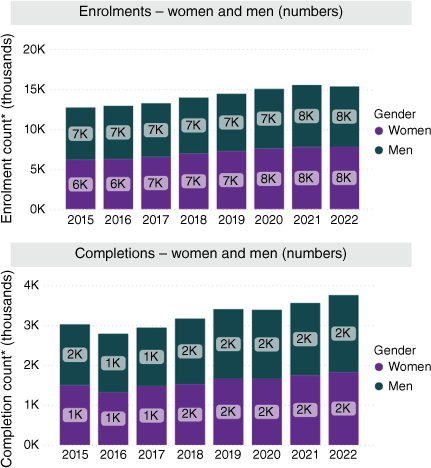
According to Kewley’s research, women PhD astronomy students are 30% of the cohort, but the percentage of women associate professors drops to 22%.66 It appears the gender gap noticeably widens due to the departure of women mid-career. This has been called the ‘leaky pipe’ syndrome, a metaphor for women leaving the sciences at intermittent intervals along the career pipeline, rather than having a clear career progression pathway, similar to that a male would typically have. It is attributed to many causes, including biased recruitment, the lack of support for women with children and the small number of female role models and mentors.
The ASA WiA Chapter developed the Pleiades awards to instigate causal change in organisations that employ astronomers through peer accountability within the profession.
The Pleiades awards
The Pleiades awards, specific to astronomy and organisations in related fields, were established by the WiA chapter. In 2014 the first awardees were announced, as shown in the photograph in Fig. 9. The award is held every two years and was initially modelled on the Athena SWAN Charter, which has come under criticism.67 The Pleiades awards aim to examine organisations and their commitment to improving gender equity performance by undertaking specific actions and reporting outcomes. There is a three-tiered system that organisations can progress through, from bronze to silver to gold. Since 2016, the IDEA Committee has administered the Pleiades awards and this has been arguably the most influential commitment made by the ASA to promote and foster diversity within the workplaces of its members.
Attendees applaud the first Pleiades awards recipients at the 2014 WiA workshop held at the Australian National University. Elaine Sadler (left) and Sarah Maddison (right) are pictured in the front row. Photograph courtesy Philip Gostelow.
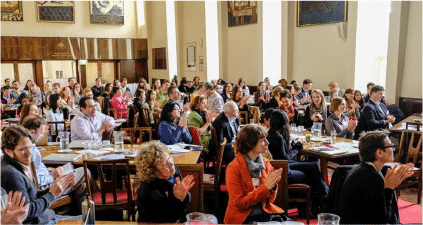
In 2018, the criteria for the Pleiades awards changed to reflect an expanded goal of equity and inclusion at all stages of member careers, and to reflect a broader range of diversity in the astronomical community. Kewley charted the Pleiades awardees from 2014 to 2018;68 in Fig. 10 her data have been extended through to 2023, showing an increase in the number of gold and silver awardees, but a reduction in the total number of organisations achieving the award.69 To be awarded gold requires a sustained commitment to gender equity, diversity and inclusion, as specified by the IDEA chapter.70 There are twenty-four organisations eligible to apply for the bronze, silver and gold award categories, but participation is not mandatory and there are concerns that considerable effort is required to prepare the information for the awards. The first recipient of a Gold Pleiades award in 2016 was the aforementioned CAASTRO and the 2018, 2021 and 2023 Gold Pleiades award recipient was the International Centre for Radio Astronomy Research at the University of Western Australia. At the same time that the ASA encouraged greater gender diversity targets and actions in the organisations its members worked in, it also reflected on itself as we shall now see.
The codes, ethics and the impact of COVID
Harassment, in any form, is an unlawful71 injustice that creates a hostile work environment. In his recent history of diversity in astronomy, Jörg Matthias Determann, demonstrates that there have always been astronomers who were marginalised in society, and he cited a well-known example of sexual harassment and bullying at CSIRO that became public in 2012. In this case, the male perpetrator was minimally impacted, but the female astronomer felt compelled to resign.72 This incident was influential in instigating discussion within the ASA. In 2019, the ASA made changes to its code of conduct and statement of ethics and put in place detailed processes to report and act on breaches. An Ethics and Conduct Committee is charged with oversight of these documents and processes.73
In 2020, the IDEA chapter introduced a COVID fund to provide amounts up to $1000 to support members during the disruption of the COVID-19 pandemic. It provided for expenses such as medical, inclusive of mental health services, data, internet costs, the ASA membership fee for one year, legal fees and training. In 2022, President John Lattanzio reported that twenty-seven students and early career astronomers had been supported by this fund since its inception74 and that the IDEA Community Fund, aimed at supporting ASA members facing financial difficulty, would now replace the COVID fund.75 That year the IDEA chapter formed the Community Action Committee to develop accessible best practice guidelines for diversity, inclusion and equity in the astronomy community.76
Increased acknowledgement and representation of women
We have affirmed that the ASA is a representative body for Australian astronomers, by comparing ASA membership data to a survey conducted in 2020 of fifteen Australian institutions selected as representative of astronomy educators and the workforce by the Academy of Science.77 We found that 74% of astronomers employed by these organisations were ASA members and that 68% of the PhD students studying astronomy in those institutions were members.78
In 2023, there were 777 ASA members, excluding corporate members and alumni, as shown in Fig. 3, and the total percentage of females reached 31% of all ASA members, as shown in Fig. 4. The percentage of women, when compared to men, who are ‘full members’, reached 29% in 2023, just over the national percentage of women working in astronomy in 2020 (27%).79 Recent diminishing of the upward trajectory is likely influenced by the rise in the percentage of women who are fellows and the upward trajectory of women honorary fellows as shown in Fig. 4.
The percentage of women who are fellows, indicating that they have an established record in astronomical research and publication, has reached 19% in 2023. One ASA honorary fellow membership is awarded each year. The percentage of women who have been awarded honorary fellowships from 1969 to 2023 was 24%, but since Elaine Sadler became the first female honorary fellow in 2011, 46% of the awards have been to women. This is evidence of cultural change.
Furthermore by 2023, the percentage of female student members had climbed back up to the 1990 figure of 40%. This too indicates a positive trend but, as history demonstrates, identifying barriers to inclusion and diversity and then removing those barriers needs to be on-going.
It is clear that as the global peak body for astronomers, the IAU has been influential in the strategies developed and implemented by the ASA, nonetheless as an organisation it too has not achieved its goal for an equitable representation of women in its membership. Of 12,737 members worldwide, 22% identify as women and out of the 347 Australian IAU members there are eighty-four (24%) women, as of September 2024.80 The IAU Executive Committee Women in Astronomy Working Group 2022–3 Report states that success has been achieved in raising awareness of gender bias and discrimination, and that the careers of women have been improved.81
In 2022 women comprised 48% of the Australian workforce, and until women constitute an equivalent percentage of the astronomy workforce, and other marginalised groups are represented in proportion to the population, substantial change is required.82 One of the areas where success has been achieved in the ASA is in ‘naming’ and encouraging applications for awards from both genders.
Prizes, awards and keynote lectures
The ASA has three prizes named after women who have inspired others and helped instigate change: the Charlene Heisler prize, the Louise Webster prize, and the Anne Green prize.83 As previously mentioned, the naming of prizes, awards and keynote lectures after male and female astronomers is an important part of the recognition of diversity.
In the 2021/22 Annual Report, ASA President John Lattanzio noted the membership had an increased expectation of female nomination, from 20 to 30%, for all awards, prizes and lectures. As nominations for membership, prizes and awards must be supported by the nominee’s supervisor, the ASA is dependent on them and their university or other organisation not holding conscious or unconscious bias. The percentage of women and non-binary members, who have been awarded prizes is monitored annually and reported to the ASA Council. Cumulative data for each award is shown in Fig. 11. The Bok prize, established in 1989, has a success rate for females of 34% and the Anne Green prize, that was established in 2018 for mid-career researchers, has been awarded to 65% female and non-binary nominees.84 Recent improvements in gender balance are demonstrated over the past six years from 2018 to 2023, as shown in Fig. 12.
The Harley Wood lecture was established in 1984 in honour of the first president of the ASA, Harley Weston Wood, who was a strong advocate for public outreach and played an important role in establishing the ASA.85 This prestigious lecture is open to the public and generally held annually as part of the ASM; there were exceptions in 2020 and 2021 due to COVID restrictions. In 1987, the inaugural address was delivered by radio astronomer Paul Wild and in 2023 astronomer, science communicator, author and Gomeroi woman, Krystal De Napoli, presented ‘Deadly’ Dark Skies: Aboriginal and Torres Strait Islander Astronomy. There have been thirty-five Harley Wood lectures, of which seven (20%) were delivered by women.86
The Robert Ellery lecture was established in 1991 and is awarded once every two years to an individual who has made an outstanding contribution to astronomy or a related field. It is named after the first director of Melbourne Observatory, who contributed significantly to astronomy in the latter part of the nineteenth century. The recipient presents a keynote lecture at the ASM and receives a modest financial reward. There have been sixteen lectures, of which three (19%) were delivered by women.87 The Robert Ellery and Harley Wood lectures have improved gender balance in recent years and the percentages shown here reflect historical bias.
The naming of objects, places and anything in the public sphere is an important way organisations recognise diverse views in astronomy. The IAU has responsibility for officially naming stars, lunar craters and other astronomical features. Of the 1578 lunar craters on the Moon there are thirty-two named after women astronomers. Priscilla Bok, the previously mentioned American astronomer, who worked at Mt Stromlo, is named on crater ‘Bok’ with her husband, Bart. There have been other efforts to increase the number of women, who are commemorated by name in astronomy globally, for example, the Vera Rubin Observatory that is due to open in Chile in 2025.
As well as gender, the IAU recognised cultural diversity when, in 2017, it announced that eighty-six stars were officially named/renamed according to Indigenous cultures from around the globe, including four stars that now have Australian Aboriginal names. Three star names are from the Wardaman people of the Northern Territory: Larawag, Wurren and Ginan. One name from the Boorong people of western Victoria is Unurgunite.88
In addition to the influence of the IAU on Australian astronomy, the ASA operates within the cultural influence of other astronomical societies and research organisations. The following outline of gender diversity related initiatives in the Australian Institute for Physics and the peak astronomy organisations in North America and United Kingdom, provides a brief comparison.
Diversity within other astronomical and related societies
The Australian Institute of Physics (AIP) is an advocate for the Australian physics community and has taken action to address its even lower percentage of women working in physics89 than astronomy. It has a Diversity and Equity Group in Australian Physics (DEGAP) group and targeted programs and awards. The high profile annual Women in Physics lecture tour was instigated in 1997. The Ruby Payne-Scott medal for early career physicists was established in 2013 and the first Women in Leadership medal was awarded in 2022. By comparison with the AIP’s DEGAP group, the ASA’s IDEA chapter is more active with its members and different to DEGAP in engaging men, as well as women, on its committee.
Like the IAU, the UK Royal Astronomical Society (RAS) and the American Astronomical Society (AAS) each have dedicated committees and workshops to improve diversity, and we will briefly outline their approach. The RAS Committee on Diversity in Astronomy and Geophysics advises on membership policy and strategy to increase diversity, as well as monitoring its progress in astronomy and geophysics.90 In partnership with the Royal Society of Chemistry and the Institute of Physics, research into workplace discrimination and inclusion of LGBTQI+ physical scientists was commissioned by the RAS. There were 487 respondents to an online survey and a separate focus group. The final 2019 report revealed that 28% of LGBTQI+ respondents had considered leaving their workplace because of the adverse environment. A critical finding was that the international nature of science meant diverse cultures had differing behaviours and that the workplace was improved by networks for LGBTQI+ scientists and by an environment that made it comfortable for people to come out.91
The AAS has a Committee for the Status of Women in Astronomy with an active website featuring a Women in Astronomy Blog and international meetings on the status of women in astronomy.92 Additionally, the AAS has a Committee on the Status of Minorities in Astronomy and a Committee for Sexual-Orientation and Gender Minorities in Astronomy (SGMA). SGMA produced an extensive LGBT+ Inclusivity in Physics and Astronomy best practices guide. All AAS committees advise on policy through resolutions and other forms of consultation, such as a compilation of essays addressing inequality and diversity published in 2024.93
Conclusion
Historically we have seen that women working in astronomy have faced many legal barriers to forging paid careers, and that most of these were common to women working in other areas of science because universities and commonwealth government organisations were the main employers. This changed incrementally after what’s called the ‘second wave’ of feminism led the fight for the marriage bar to be removed (1966), maternity leave to be available (1973), the banning of sex discrimination (1984) and the Fair Work Act (2009) that workplace change made equity possible. There is a correlation between changes in the laws governing workplace conditions and gender equity in astronomy workplaces, but also change can be instigated and implemented within the profession.
Cathy Foley, who is currently Australia’s chief scientist, isan advocate for the increase in the number of women physicists in Australia. She proselytised in 2023: ‘I used to talk about how to adapt to the system. Now I know it is the system that needs to change—not the women’.94
Although gender parity was achieved in the ARC Centre of Excellence for All Sky Astrophysics in 3-Dimensions, gender equity in the overall astronomy workforce appears to have plateaued95 and this is reflected in the ASA membership. In 2023 the representation of women across all membership types in the ASA was 31%.96 Notwithstanding this, the Australian astronomy decadal plan goal of 33% participation of women by 202597 will likely be met due to the success of the ARC centres of excellence in achieving gender equity. These are encouraging examples of systemic change, but there may be a deeper long term problem.
Opportunities for school students to engage with female astronomers are offered by individuals and organisations, but are still relatively rare for most. Encounters such as these are highlighted by Kewley and others98 as vital in ensuring the removal of stereotyping and enabling female students to see that they can thrive in this physical science. There are many outstanding women in the history of astronomy in Australia, some of whom are mentioned in this paper, and their achievements could be included in school science curricula. The ASA, as one of the peak bodies for awarding and publicising astronomers, is well-placed, if provided resources, to connect with educators about opportunities for female and LGBTQI+ students in astronomy.
For over three decades, the ASA as an organisation has demonstrated leadership and commitment to assess and address gender and other forms of inequality within the ASA and in Australian astronomy more broadly. The ASA has addressed inequity pro-actively, inviting women to stand for election to as vice president and president and as members of its council, with appointment on merit. The IDEA chapter and the Pleiades awards are examples of astronomy-specific strategies that have been effective and embraced. Positive action by the ASA has resulted in the percentage of women elected as fellows and honorary members increasing, with outcomes for student membership and increased representation of female students. The ASA leadership has been consistent since its nascence in aiming to meet the changing workplace environment, and, in more recent years, acting on ideas to improve diversity not only in its membership, but in astronomy in Australia.
Even though there are national strategies that include maternity and carer's leave legislation and rulings on diversity and sexual harassment to address gender and diversity in all workplaces, with incremental improvements to the Fair Work Act 2009, the departure of women mid-career is still likely unless stringent measures, such as those adopted by the ARC centres of excellence, are put in place.
Data availability
Most of the ASA membership lists that were used for this research are published in the society’s Publications (originally, Proceedings). Photographs were sourced from the ASA Website and permission was granted from the National Archives for the photograph of Bart and Priscilla Bok in Fig. 1 and by Philip Gostelow for Fig. 8.
Acknowledgements
The authors are grateful to Associate Professor John O’Byrne, the secretary of the Astronomical Society of Australia, for his support and the provision of electronic membership lists that enabled this research to be carried out. We also acknowledge Dr Devika Kamath, chair of the IDEA chapter, for assistance with Pleiades awards data and Dr Marc Duldig, Emeritus Professor Anne Green, Professor John Lattanzio, Dr Ashley Ruiter and Professor Elaine Sadler for providing constructive comments. Associate Professor Jane Carey’s comments were especially helpful and Dr Andrew Jacob’s insightful.
References
American Astronomical Society (2024) ‘Committee on the Status of Women in Astronomy’, https://aas.org/comms/cswa, viewed May 2024.
Armstrong, J., and Sullivan, A. (2024) A critical analysis of Athena Swan as a policy-scoring scheme, British Educational Research Journal, 00, 1-19 viewed September 2024.
| Crossref | Google Scholar |
Astronomical Society of Australia (1969) List of members, Proceedings of the Astronomical Society of Australia, 1(5), 250-252.
| Google Scholar |
Astronomical Society of Australia (1979) List of members 1979, Publications of the Astronomical Society of Australia, 3(6), 412-416.
| Crossref | Google Scholar |
Astronomical Society of Australia (1990) List of members, Publications of the Astronomical Society of Australia, 8(4), 393-397.
| Crossref | Google Scholar |
Astronomical Society of Australia (2009) ‘President’s report 2008/09’, https://asa.astronomy.org.au/wp-content/uploads/2020/09/President_Rep_2009.pdf, viewed March 2024.
Astronomical Society of Australia (2010) ‘President’s report 2009/10’, https://asa.astronomy.org.au/wp-content/uploads/2020/09/President_Rep_2010.pdf, viewed March 2024.
Astronomical Society of Australia (2012) ‘President’s report 2011/12’, https://asa.astronomy.org.au/wp-content/uploads/2020/09/President_Rep_2012.pdf, viewed March 2024.
Astronomical Society of Australia (2021) ‘President’s report 2020/21’, https://asa.astronomy.org.au/wp-content/uploads/2021/07/ASA_Presidents_Report_2020_2021.pdf, viewed March 2024.
Astronomical Society of Australia (2023a) ‘President’s report 2022/23’, https://asa.astronomy.org.au/wp-content/uploads/2023/11/Presidents-Report-2022-23.pdf, viewed March 2024.
Astronomical Society of Australia (2023b) ‘Constitution’, https://asa.astronomy.org.au/wp-content/uploads/2023/03/ASA.constitution-at-14-Mar2023.pdf, viewed May 2024.
Astronomical Society of Australia (2024) ‘IDEA chapter: the pleiades awards’, https://asa-idea.org/the-pleiades-awards/, viewed May 2024.
Australian Academy of Science National Committee for Astronomy (2005) ‘New horizons: a decadal plan for Australian Astronomy 2006-2015’, https://www.science.org.au/files/userfiles/support/reports-and-plans/2005/astronomy-decadalplan-2005-web.pdf, viewed September 2024.
Australian Academy of Science National Committee for Astronomy (2015) ‘Australia in the era of global Astronomy, the decadal plan for Australian Astronomy 2016–2025’, https://www.science.org.au/files/userfiles/support/reports-and-plans/2015/astronomy-decadal-plan-2016-2025.pdf, viewed March 2024.
Australian Academy of Science National Committee for Astronomy (2020) ‘A survey of demographics in Australian astronomy institutes’, https://www.science.org.au/files/userfiles/about/documents/demographics-paper.pdf, viewed March 2024.
Australian Government (1984) ‘Sex Discrimination Act 1984’, https://www.legislation.gov.au/C2004A02868/2021-09-11/text, viewed May 2024.
Australian Government (2009) ‘Fair Work Act’, in ‘Federal Register of Legislation’, https://www.legislation.gov.au/C2009A00028/latest/versions, viewed March 2024.
Australian Government (2022) ‘Gender equality workplace statistics at a glance 2022’, https://www.wgea.gov.au/publications/gender-equality-workplace-statistics-at-a-glance-2022, viewed October 2024.
Australian Government (2023a) ‘Review of the maternity leave (Commonwealth Employees) Act 1973’, in ‘Australian Public Service Commission’, https://www.apsc.gov.au/sites/default/files/2023-06/20230613%20ML%20Act%20Review%20-%20FINAL%20REPORT.pdf, viewed March 2024.
Australian Government (2023b) ‘University enrolment and completion in STEM and other fields’, https://www.industry.gov.au/publications/stem-equity-monitor/higher-education-data/university-enrolment-and-completion-stem-and-other-fields, viewed September 2024.
Bhathal, R. (1973) Australian Astronomers Oral History Project, National Library of Australia, https://catalogue.nla.gov.au/catalog/1588790, viewed May 2024.
Bhathal, R. (2001) Women astronomers in Australia, Astronomy & Geophysics, 42(4), 4.29-4.30.
| Crossref | Google Scholar |
Brough, S., Bauer, A., Brooks, K., Hopkins, A., and Maddison, S. T. (2011) ‘Women in Astronomy workshop report’, https://www.researchgate.net/publication/51914189_Women_in_Astronomy_Workshop_Report, viewed March 2024.
Commonwealth of Australia (1998) ‘Equal Pay handbook, human rights and equal opportunity commission’, https://humanrights.gov.au/sites/default/files/content/pdf/sex_discrim/equal_pay.pdf, viewed March 2024.
Commonwealth Public Service (1902) An Act for the Regulation of the Public Service, Regulation 90(d), https://classic.austlii.edu.au/au/legis/cth/num_act/cpsa190251902309/, viewed May 2024
Deacon, D. (1982) The employment of women in the Commonwealth Public Service: the creation and reproduction of a dual labour market, Australian Journal of Public Administration, 41(3), 232-250.
| Crossref | Google Scholar |
Ekers, R., Goss, W., and Hooker, C. (2023) Joe Pawsey and the Founding of Australian Radio Astronomy: Early Discoveries, from the Sun to the Cosmos, Springer Nature. 10.1007/978-3-031-07916-0
Foley, C. (2023) ‘The case for more women in quantum’, IBM Quantum Women invited talks, https://www.chiefscientist.gov.au/sites/default/files/2023-10/FOR%20WEBSITE%20The%20case%20for%20more%20women%20in%20quantum_0.pdf, viewed March 2024.
Graham, A. W., Kenyon, K. H., Bull, L. J., Lokuge Don, V. C., and Kuhlmann, K. (2021) History of astronomy in Australia: big-impact astronomy from World War II until the Lunar landing (1945–1969), Galaxies, 9, 24 viewed May 2024.
| Crossref | Google Scholar |
Hill, T. (2014) ‘We are all made of stars’, The Conversation, https://theconversation.com/we-are-all-made-of-stars-31117, viewed February 2024.
International Astronomical Union (1973) Astronomy ’73, https://www.iau.org/static/publications/ga_newspapers/19730821.pdf, viewed September 2024.
International Astronomical Union (2009) ‘She is an astronomer’ https://www.sheisanastronomer.org/profiles, viewed March 2024.
International Astronomical Union (2017) ‘IAU approves 86 new star names from around the world’, Press Release, https://www.iau.org/news/pressreleases/detail/iau1707/, viewed February 2024.
International Astronomical Union (2023) ‘Executive committee women in Astronomy Working Group 2022-23 Report’, https://www.iau.org/static/science/scientific_bodies/working_groups/122/wg-wia-annual-report-2022-2023.pdf, viewed February 2024.
International Astronomical Union (2024a) ‘Geographical and gender distribution of individual and junior members’, https://www.iau.org/administration/membership/individual/distribution/, viewed September 2024.
International Astronomical Union (2024b) ‘Executive committee WG astronomy for equity and inclusion’, https://iau.org/science/scientific_bodies/working_groups/259/, viewed May 2024.
Keast, V. J. (2022) Gender bias in New South Wales Higher School Certificate (HSC) physics, Australian Journal of Education, 66(1), 26-39 viewed July 2024.
| Crossref | Google Scholar |
Kewley, L. J. (2019) Diversity and inclusion in Australian astronomy, Nature Astronomy, 3, 1067-1074.
| Crossref | Google Scholar |
Kewley, L. J. (2021) Closing the gender gap in the Australian astronomy workforce, Nature Astronomy, 5, 615-620.
| Crossref | Google Scholar |
Kewley, L. J., Wyithe, J. S. B., Tran, K. V., and McCarthy, I. (2023) The achievement of gender parity in a large astrophysics research centre, Nature Astronomy, 7(12), 1525-1531.
| Crossref | Google Scholar |
Knezek, P. (2017) Implicit bias in astronomy, Nature Astronomy, 1, 0151.
| Crossref | Google Scholar |
Lomb, N. (2015) How astronomers focused the scope of their discussions: the formation of the Astronomical Society of Australia, Historical Records of Australian Science, 26, 36-57.
| Crossref | Google Scholar |
Lomb, N. (2018) Scientific society journals: the publications of the Astronomical Society of Australia, Historical Records of Australian Science, 29, 112-121.
| Crossref | Google Scholar |
Lomb, N. (2020a) Australia and the International Astronomical Union: the 1973 Sydney general assembly, Historical Records of Australian Science, 31, 118-126.
| Crossref | Google Scholar |
Lomb, N. (2020b) Australia and the International Astronomical Union: the 2003 Sydney General Assembly, Historical Records of Australian Science, 32, 83-97.
| Crossref | Google Scholar |
Lomb, N., and Stevenson, T. (2024) Spreading across the continent: the Astronomical Society of Australia 1966–2023, Historical Records of Australian Science,
| Crossref | Google Scholar |
Maasoumi, F., Maddison, S., and Foley, C. (2023) Women in physics in Australia 2021, 2023 AIPC, 3040, 050003, 10.1063/5.0175566, viewed March 2024.
New South Wales government (2024) ‘2024 HSC facts and figures’, https://www.nsw.gov.au/education-and-training/nesa/hsc/facts-and-figures/2024-hsc-facts-and-figures/course-enrolments#toc-hsc-general-enrolments, viewed October 2024.
Norman, D., Sacco, T., and Russell D. (2024) An Astronomical Inclusion Revolution: Advancing Diversity, Equity, and Inclusion in Professional Astronomy and Astrophysics, AAS-IOP Publishing, Bristol. 10.1088/2514-3433/ad2174
Norris, R. (2010) Australian aboriginal astronomy in the international year of astronomy 2009, CAPjournal, 9, 5-9.
| Google Scholar |
O’Neill, J. P. (1970) Social Statistics: Australia, 75, University Statistics (Preliminary), Commonwealth Bureau of Census and Statistics, https://www.ausstats.abs.gov.au/ausstats/free.nsf/0/DCD614466ECEEFE0CA25744200079C07/$File/42070_1969.pdf, viewed September 2024.
Professionals Australia (2015) ‘The slower track: women in STEM professions study report’, https://www.agec.org.au/wp-content/uploads/2018/09/The-Slower-Track-Women-in-the-STEM-Professions-Survey-Report-2015.pdf, viewed September 2024.
Royal Astronomical Society (2022) ‘Committee on diversity in astronomy and geophysics’, https://ras.ac.uk/about-ras/committees/committee-diversity-astronomy-and-geophysics-cdag, viewed May 2024.
Sadler, E. (2015) ‘CAASTRO and Gender Equity’ presentation to ASA Women in Astronomy chapter, 7 July 2015’, https://slideplayer.com/slide/9039000/, viewed March 2024.
Sim, H. (2009) ‘Astronomy in October 2009’, in ‘Science in Public’, https://www.scienceinpublic.com.au/astronomy-year/astronomy-in-october-2009, viewed March 2024.
Stevenson, T. (2014) Making visible the first women in astronomy in australia: the measurers and computers employed for the astrographic catalogue, Publications of the Astronomical Society of Australia, 31, e018.
| Crossref | Google Scholar |
Stevenson, T. (2015) Measuring the Stars and Observing the Less Visible: Australia’s Participation in the Astrographic Catalogue and Carte du Ciel, University of Sydney, http://hdl.handle.net/2123/15762, viewed September 2024.
Stevenson, T. (2023) Melbourne observatory’s astrographic women: star measurers and computers, Journal of Astronomical History and Heritage, 26, 325-338.
| Crossref | Google Scholar |
Storey, J. W., and Faulkner, D. J. (1991) Betty Louise Turtle (1941–1990), Publications of the Astronomical Society of Australia, 9(1), 6-7 viewed September 2024.
| Crossref | Google Scholar |
Wild, J. P. (1971) The beginnings of radio astronomy in Australia, Historical Records of Australian Science, 2, 52-61.
| Crossref | Google Scholar |
Footnotes
3 Carey (2023).
4 Hooker (2004) p. 12.
5 Kelly (1993) p. 27.
6 Carey (2023) p. 44.
7 Lomb and Stevenson (2023), p. 65.
8 Graham and others (2021) pp. 2, 20 and 35. Haynes and others (1996) pp. 171 and 173.
9 Kelly (1993) pp. 45–50. Hooker (2004) p. 167. Carey (2023) p. 9.
10 Carey (2023) pp. 233–238.
11 Bhathal (2001).
12 Kelly (1993) p. 51. Hooker (2004) p. 39. Carey (2023) p. 66.
13 Stevenson (2014).
14 Stevenson (2015) p. 213.
16 Irving in Caine and others (1998) pp. 25–32.
17 Home and others (1988) p. 221. Gascoigne in Home and others (1988) p. 345.
19 Hooker (2004) pp. 158–166. Haynes and other (1996). Goss and McGee (2010) p. 68. Graham and others (2021).
20 Larbalestier in Caine and others (1998) pp. 152–155.
21 Lomb (2015).
22 Commonwealth Public Service (1902). Also of note is that the states applied similar rulings in their employment acts.
23 Deacon (1982).
24 Commonwealth of Australia (1998) p. 20.
25 Caine and others (1998) pp. 432–434.
26 Stevenson (2023).
27 Australian Government (2023a) review of the Maternity Leave (Commonwealth Employees) Act 1973.
30 Lomb (2015) pp. 12–13. Note that Donna Dee Hain also published as Donna Dee Shinkawa, and Louise Webster was also known as Betty Louise Turtle.
31 O’Neill (1970).
33 Storey and Faulkner (1991). Haynes and others (1996) p. 360.
34 Graham and others (2021) pp. 32–33.
35 Lomb (2020a).
37 Beverley June Wills (née Harris) doctoral thesis was supervised by Robert Hanbury Brown and can be read here https://doi.org/10.25911/5d6f9cec8bab2, viewed October 2024.
38 Carey (2023) p. 235.
40 Lomb (2018).
43 The five female ASA presidents are Elaine Sadler 1995–1996, Anne Green 2003–2004, Kate Brooks 2011–2012, Virginia Kilborn 2015–2016, Catherine Trott 2019–2020. Astronomical Society of Australia website https://asa.astronomy.org.au/wp-content/uploads/2023/07/Presidents.pdf, viewed May 2024.
44 Bhathal (2001). Haynes and others (1996) pp. 369 and 428.
45 Lomb (2020b) p. 13.
49 Norris (2010).
50 Sim (2009).
51 Bhathal (1973). Interviews were conducted from 1973 and are held at the National Library of Australia.
56 Hill (2014). Also called subconscious or implicit bias this is a set of expectations used to judge people due to their gender, ethnicity, physical, cultural and other characteristics. By ‘blind’ assessments some of this is removed (Knezek 2017).
57 Sadler (2015).
63 Kewley (2021).
65 Keast (2022).
66 Kewley (2021).
67 Armstrong and Sullivan (2024) have criticised the Athena SWAN Charter, specifically about the way gender is defined, the strain on resources to collect data, the expansion of the program beyond STEMM fields and the lack of evidence about the impact of the awards, amongst many other issues of concern. They agree that the charter has raised the profile of women in science in the United Kingdom, and that collecting data about gender equity is important.
68 Kewley (2019) p. 1068.
69 Kewley (2019) p. 1068.
72 Determann (2023) pp. 65–83.
73 Determann (2023) p. 75.
85 Lomb (2015).
86 Penny Sackett in 2002, Elaine Sadler in 2010, Tanya Hill in 2015, Tara Murphy in 2017, Lisa Kewley in 2018, Kirsten Banks in 2019 and Krystal De Napoli in 2023.
89 Maasoumi and others (2023). Female physicists are less than 20% of the workforce.
91 Dyer and others (2019) pp. 5–8.
94 Foley (2023) p. 3.


